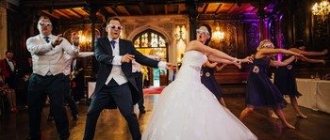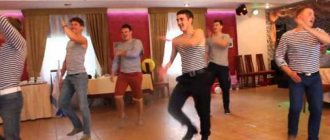Dancing can be considered a universal hobby. There are several benefits to this hobby. Classes improve the outline of the silhouette, provide a healing effect, add grace to movements, and give a boost of energy and good mood. The popularity of this type of fitness is growing rapidly; in every city and town there are schools and studios that teach the basics of choreography. But many would like to know how to learn to dance at home. Visiting fitness centers and schools can create certain difficulties. Some people don’t have the time or money for this, while others feel embarrassed. In any case, you need to understand that self-study at home will provide positive results if you approach it competently and responsibly.
Pros and cons of staging a wedding dance yourself
Preparation for a wedding dance on your own has both its positive and negative sides.
Advantages:
- If the bride and groom have nothing to do with the choreography, then they may begin to feel shy in the presence of others. As a result, you won’t be able to relax and study the composition properly. If you prepare on your own, this will not happen and you will have time to get used to the idea that you will have to speak in public on your wedding day.
- The spouses will be able to thoroughly analyze all the movements, analyze their mistakes, study the partner’s abilities and choose the combinations that are most suitable for both. Ultimately, this exciting and creative process will help fill the dance with life.
- Saving money on a choreographer.
- No need to waste time traveling to the dance studio. Rehearsals can be done at home.
- Videos with your favorite compositions are available at home, which can be repeated as many times as you like.
- By learning new things together, you will be able to become a full-fledged dancing couple on your wedding day.
Flaws:
- Serious motivation is needed, otherwise the slightest misunderstanding between the bride and groom risks resulting in the cessation of classes.
- It is difficult to calculate your own strength by choosing a composition and melody that matches the physical fitness of both participants.
- Lots of nuances to consider.
- There is no one to explain exactly what to do and how to perform certain figures. This can lead to a lack of interaction in the couple.
- Rehearsing at home does not create the right atmosphere that would charge you with energy and positivity. In such an environment, at the first failures one can easily give up.
How to learn to dance well at home
Before starting training at home, a time suitable for training is determined. It is better to allocate from 60 to 90 minutes at least 2 times a week. You also need to take care of suitable clothes, shoes, and video materials for lessons. Learning to dance well at home is only possible with a responsible approach to classes. The main thing in studying at home is regularity and discipline. You need to clearly define the goal and go towards it, and then dancing will bring pleasure and results.

We choose what style of dance we want to learn
Not all areas are suitable for home study due to their specific features. It is better to select those areas where the presence of a trainer is not necessary, and outside help or additional equipment is not needed to perform dance elements. For example, pole dancing is impossible without a pole; not everyone can perform complex elements of low breakdancing without outside help. Also, some types require the presence of a partner, for example, in certain types of Latin American dances. You need to choose a direction based on your skills and capabilities.
Incendiary, energetic dances, where all movements must be repeated after the trainer on the screen, are best suited for training at home. One of the popular types is Zumba. This direction combines samba, hip-hop, flamenco and belly dance. In addition to a good mood, self-confidence and stress relief, Zumba classes promise to tighten your figure, strengthen your muscles and improve your posture.
Findable video tutorials in this style for beginners
Having decided on the direction, it’s time to look for the base on which the lessons will be built. It is better to give preference to video lessons for beginners, in which the trainer consistently and slowly talks about all the features of the chosen style. You can find such videos on the Internet, in thematic groups on social networks, and on video hosting sites. There are many lessons, paid and free, that can teach a beginning dancer. Video lessons can be entire collections aimed at teaching all the intricacies of the chosen style. You can also find short videos, for example for those who want to learn new dance moves at a club or at a party.
Let's start from the very basics
Training does not like to be rushed; you need to start classes gradually, with simple movements. In some cases, they start by learning the stance and different positions before moving on to more complex elements. Some elements of the dance can be difficult, so the sequence of training is very important. It is necessary to carefully study safety precautions before classes to avoid injury.
Don't forget about warming up and stretching
In dancing, as in any sport, there is a high probability of injury. The most popular of them are sprains, dislocations and even fractures. To reduce the risk of such troubles, it is necessary to warm up your muscles and stretch your joints before exercise. Professional trainers recommend stretching before and after training to reduce the risk of injury and consolidate the results of the session. Particular attention should be paid to the ankle, shoulder and knee joints.
Dancing in front of the mirror
A mirror is an indispensable assistant in home training, without which it is almost impossible to learn to dance well. When practicing using a video lesson, it is important to monitor the correctness of your movements, comparing them with the movements of the trainer. It is not by chance that mirrors are hung in dance schools: with the help of it you can track your progress in learning new elements, become more confident and relaxed.
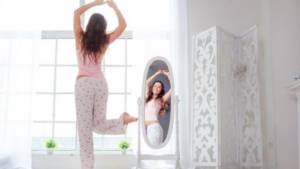
Developing a sense of rhythm
Professional dancers and coaches recommend listening to music before you start dancing to it. Not everyone has an ideal ear for music, and some find it especially difficult to feel the music and move in time with it. Trainers advise beginners to count to themselves to 8, bending their knees or snapping their fingers with each count. If you have difficulty moving in time with the music, you can remember how people dance in clubs - the main thing is to relax and try to feel the melody.
We train regularly
One of the most important conditions for home training is regularity. One missed lesson leads to another, and then learning is put on the back burner. To prevent this from happening, you need to make a schedule, keep a notebook with your successes, where you can mark the lessons you have completed and set new goals. You can study only 2 times a week, without missing lessons, and then the result will not take long to arrive.
Useful tips for beginners
What else do those who want to learn to dance need to know:
- Convenient form for classes. Clothes should not restrict movement, shoes should not rub. Some dance styles require certain specific shoes, for example, for Irish dancing you will need special shoes with low heels.
- Confidence and determination. During group classes, there is no need to be shy or afraid to express yourself. Tightness and uncertainty will not bring results.
- Smile and good mood. The main companion to a good result is a positive attitude. Even when working out at home, you need to smile at yourself; the result of any workout depends on the right attitude.
- Constant learning. Following dance competitions is not only interesting, but also useful. Professional dancers motivate, and you can learn new movements.
- Dancing in your free time. Discos in clubs are a great place to learn how to dance rhythmically and feel the music.
When should you start preparing?

If the newlyweds have at least a little experience, then they can learn a wedding dance in 1-2 weeks. Rehearsals in this case can be held once every 3 days for 1 hour. If there is no dance practice, then the optimal time is 1.5-2 months. During this period, the couple must select a composition, choose suitable music and learn the movements, not forgetting to form them into a beautiful dance. If you don’t plan to perform any complex lifts, turns and all other elements at the wedding, then a month is enough for preparation.
How to learn to dance modern dances
From this direction we have chosen three types that can often be found in the schedules of fitness clubs and dance schools. And the first is plastic and incredibly beautiful contemporary art.
Contemporary
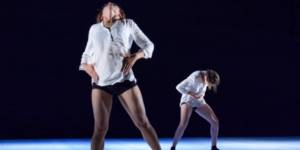
Contemporary mixed elements of modern jazz, yoga and martial arts, seasoned with improvisation and attention to breathing. This is freedom and plasticity - the natural beauty of movement.
Here is a video with a combination in contemporary style. Give it a try, just be sure to warm up and stretch thoroughly before teaching.
And here is the second part:
By the way, about warming up. The video below contains a full lesson with warm-up, stretching and analysis of the combination. In English, but everything is clear without translation.
If you don’t have time to repeat or consider how a certain movement is done, set the speed to 0.25.
If you liked the combinations, but you can’t repeat them yet, here are some more videos with routine contemporary exercises.
Most likely, you will have to do the same in dance school before you can perform beautiful combinations.
Strip of plastic
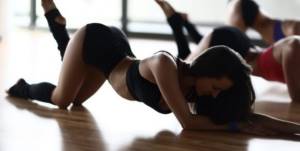
Many people confuse pole exercises and strip exercises. The second is a simply sensual dance that can be performed without a pole.
When doing strip plastic, you won’t have to stand at the machine and pull your toe. Everything here is based on the natural sexuality of the female body. Of course, many teachers diversify strip dance with elements of contemporary or modern, Latin American dances and other styles, but here everything depends on the teacher.
How beautiful your dance will look depends again on how well you can control your body, how mobile your joints are and how stretched your muscles and tendons are.
The video below contains an analysis of the combination. Not too simple, but very sensual and beautiful. And you won't have to do any movements on the floor, so your knees won't get hurt.
And here is a playlist with strip dance lessons from different dance schools. There are both individual movements and combinations.
And one more, simpler combination. Try it if the first one didn't work out.
Belly dance (bellydance)
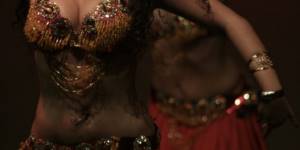
This is a sensual and beautiful dance, which, among other things, helps to develop plasticity and even get rid of some health problems.
There are a lot of belly dancing lessons on YouTube. Below are some of them.
The basic movements are explained very clearly here:
And the second part:
Below is a playlist with five lessons for beginners from another teacher.
Which wedding dance to choose
The dance style should be chosen taking into account the following:
- Your wishes.
- The character of both partners.
- Physical training.
- The presence or absence of dance experience.
- Time remaining until the holiday.
- The style of the wedding itself, for example, if it is classic, then Latin will not be entirely appropriate.
- Places where the banquet is planned to be held.
- Wedding dress.
Waltz
The most popular dance of newlyweds is the waltz, which almost all couples can perform. It comes in 4 types - Viennese, slow (baston), tango and figure.
Those who have at least some experience in choreography can pay attention to the Viennese waltz , which requires endurance, flexibility and plasticity from the performers.
Baston , being elegant and discreet, is more suitable for romantic couples.
Tango is the solution for passionate individuals who want their first dance to be remembered for a long time.
The simplest, but at the same time beautiful movements are characteristic of the figure waltz . It is especially relevant when the bride plans to get married in a fluffy wedding dress with a wide crinoline, and the groom in a classic suit.
Here is an example of a classic Viennese waltz:
Latina
For expressive people, the ideal choice would be fiery salsa and bachata, passionate paso doble and reggaeton, romantic rumba and spectacular cha-cha-cha.
You don’t need to be a professional to perform their basic movements, turns and steps beautifully. They will allow the newlyweds to show their guests the whole range of feelings that fill both of them.
It is very important that in this case, if one of the partners forgets some figures at the wedding, you can calmly improvise. There are no strict requirements for clothing and shoes here - comfortable low-heeled shoes, a dress for the bride, and an elegant suit for the groom - that's all you need!
This video shows an example of a cha-cha-cha wedding dance:
Mix
Fans of the unusual can be offered to mix movements from different styles - classic, Latin, retro. From the first it will be beautiful to take rotations, from the second - steps, and from the last - unusual supports.
This mix will really surprise the guests and add a special touch to the wedding. To be even more original, it’s just right to use music that matches their tempo for different figures, which will beautifully emphasize the transition from one style to another.
This is what the wedding mix looks like:
Retro
Boogie-woogie, elegant foxtrot and extreme rock and roll - these dances can be easily choreographed if the groom is tall and strong, and the bride is small and thin. In this case, you will need to do a lot, and sometimes very complex, supports.
Another obstacle will be the need to constantly be in motion, because such dances are based on jumping, circling, and various transitions. But they are relevant only if there is free space in the banquet hall.
Wedding dance in the style of the 20s:
How to come up with a dance?
How to come up with a dance? Composing a dance etude is a complex and capacious task, because it is creative. It requires inner freedom, awareness of the harmony of the body, musical knowledge, and most importantly, subtle taste. Just as an impression of a person is made up of a wide variety of factors and characteristics, for example, his speech, so dance is assessed by its “vocabulary”. And it depends only on you whether it will be non-standard or colorful. Before you get up and start trying to put movements to music, you need to devote more than one or two evenings to studying the vocabulary of the dance direction that you have chosen. Fortunately, there are now many Internet resources for this. - choose several, in your opinion, bright and strong numbers on the network. Watch them 3-4 times, more if necessary, depending on when the understanding of the individual movements of the performer comes to you. -keep looking, looking, looking. After watching a large number of diverse numbers, you will begin to notice their strengths and weaknesses, you will begin to understand how dances are done, what their structure is. Plus, it's easier to remember choreography when you watch it. -now start working with the music of the numbers you are viewing. If you have basic musical knowledge about meters, rhythm, beats, your task will be much easier. Try to understand how the choreography reflects the mood prevailing in the music, how the strong beats are highlighted, how the accents are placed, what place the music occupies in the number. -pay attention to how the movements are laid out in the music, how the performer transitions from one element to another. Only repeated observation will give you the opportunity to understand the smallest details and thereby gain invaluable experience. All of the above will take you on average a couple of weeks, for some more, since the volume of information received is large and requires assimilation. (provided you want to make a quality dance). Now your knowledge base has increased significantly. You know many individual elements, remember them and can depict them. You have begun to develop a taste: now you know exactly what you DO NOT want your dance to look like, but how it would be nice. There is confidence in how to do it right. Now you have come to one of the most difficult tasks in creating a dance - choosing music. This is the most important step, because everything in your dance depends on the music. When choosing music, you should keep the following in mind: 1. Don't choose the most famous hit of all time. The very first and simplest thing you will want to do, since this music is your favorite. But tens of thousands of people also like it, and this puts a burden of responsibility on you: you cannot dance badly to such music. (of course, if you plan to show your dance to someone or post it online) Do you have enough knowledge and skills to match such a composition? If you decide to do this, great. But you have to work much more and more painstakingly. 2. Music should inspire not today or tomorrow, but for many days in a row. This is the most important criterion; music is the main assistant in the work of the imagination. Search for music carefully, for a long time, until one of the compositions touches you. The search will be greatly facilitated by selections of compositions, of which there are a great many on the Internet. (they were compiled by those who have already walked the path in search of “their” music). 3. When you have settled on several compositions that you really like and inspire you, you should listen to them and choose one, no matter how difficult it may be. So, try to choose music with development: it should be interesting, changing, with a story, with a climax, with bright accents. Listen to the music and imagine the movements of your arms and legs that you can make to it. Of course, you can do a performance with monotonous music (a phenomenon that is quite fashionable and interesting), but then your choreography must be stunning in order to distract the viewer from the sound. 4. If you feel the slightest doubt about choosing music, keep looking! No time will be wasted, the music will give you a great dance.
So, you have chosen the music, now it’s time to move on to the most important thing - composing the dance. If a story comes to mind while listening, give it life! Dancing a story is always interesting, but inventing a dance becomes much easier. Next, you should apply some knowledge of the musical part. You have almost memorized all the transitions and climaxes in music, so let's get straight to the point: 1. Turn on the music and listen to it before a new musical phrase. You will hear this transition clearly. Listen again, find out how many “counts” this musical phrase takes: 16, 24 or 32? Now you know exactly how much time and “counts” you have for movements. 2. Now apply the knowledge gained while familiarizing yourself with the style and vocabulary of the dance. Depending on the tempo and accents, “arrange” the choreographic elements you like throughout the music. 3. If you remember well what you write, great. If not, then you can make a video or simply write down the order of movements on a piece of paper in words that only you can understand. 4. Calculate all the music. Pay attention to the accents in the music, highlight them with choreography. Congratulations! The skeleton of the dance is ready. Ask: “Why a skeleton?” It's simple: creativity has no limits! In the process of learning your own dance, you will be surprised to find that you want to add one or another element that you like better, replace it with a more complex one. Creating a dance is about constant improvement. Develop, experiment, improvise. Live your dance!
What song to perform the first wedding dance to?
It’s worth looking for suitable music for dancing after choosing it. For ballroom performance, the most successful compositions will be the following:
- Sin Ti – Olga Tanon (samba)
- Tango_Forte – Duplex_Inc (tango)
- Am Who I Am – Lara FabianI (rumba)
- Vom Tod – Das Lied (paso doble)
- Obsession – Aventura (salsa)
- Abreme la Puerta – Antony Santos (bachata)
- Ain't Nothing W – Robert Randolph & The Family Band (jive).
The following melodies will help you waltz beautifully:
- My affectionate and gentle animal – Zara
- Blut – Wiener
- Hfchelbels Cannon – Louis Clark
- Sans voir le jour – Enrico Macias
- Baston - Alexander Rosembaum.
Those who choose a retro style production should listen to the following compositions:
- Angels – the Baseballs (rock and roll)
- Jailhouse Rock – Elvis Presley (boogie-woogie)
- Detroit Swing City – Liberation Records (foxtrot)
- The Great Gatsby – Gunther Noris
- Candyman – Christina Aguilera.
Having chosen the “mix” style, it will be interesting to combine musical compositions from the list of retro, Latin and classical.
What to consider when choreographing a dance

If the area is small, then you won’t be able to waltz along it as needed, moving from side to side. In this case, it is more appropriate to come up with some more compact movements. A dance with high supports, typical of Latin and rock and roll, can be ruined by low ceilings in the room. Thus, the bride will not be able to jump into the groom’s arms, which will lead to not all elements being completed.
Floor. The material from which the floor of the hall is made is also of great importance. It will be very difficult to navigate if it is tiled. In this case, you should think about comfortable shoes without heels, which are not suitable for all dance styles.
If the flooring is parquet, then you can safely take figures from Latin, waltz, and retro. But since it can creak, it is better to rub the shoes of both partners with special compounds. Also, when dancing on it, there is a high risk that the newlyweds will lag behind each other due to poor gliding.
Shoes. It is better to exchange the bride's wedding shoes for a spare, stable pair. These can be ballet shoes, models with wedges or heels.
To avoid injuring your partner due to inexperience, it is better to avoid high heels. You should not choose them even when there is a small difference in height between the newlyweds, so that the partner does not end up taller. In this case, it will be very difficult to perform complex choreographic elements.
Guests. The location of the guests must also be taken into account. If the tables are placed on one side, then it is unacceptable for the couple to turn their backs to the audience. Then the steps should be taken from left to right or in the other direction. When placing them around the entire perimeter of the hall, you need to select circular movements so that everyone can see the bride and groom.
Photo and video shooting. Don’t forget about the work of a videographer with a photographer. In order for them to have the opportunity to capture the heroes of the occasion in an interesting and high-quality manner, they need to know in advance about their location in the banquet hall. But usually photography takes place from the right or left side.
Duration. A wedding dance usually lasts no longer than 2-3 minutes. For untrained performers, spinning on the floor for longer will be difficult - they will experience shortness of breath and begin to sweat. It won’t take long for the wedding dress to deteriorate, the style of which also plays an important role in the staging of the wedding dance.
Cloth. If the outfit is too loose, then you can get tangled in it and fall. It will also be inconvenient to support the groom when the bride needs to be circled and picked up.
However, too narrow long models are not an option, since it will be difficult to move freely around the hall in them. This way you won’t be able to repeat either the graceful swings of your legs or the sharp transitions in a waltz. In this case, the dance risks turning into standing still.
A short wedding dress gives complete freedom of imagination, allowing you to fulfill absolutely all the planned elements.
How to organize rehearsals correctly: useful tips
Here are some useful tips to help you organize your rehearsals correctly:
No more than 3 days , otherwise the memorized movements may be forgotten.

in shoes and clothes that are as similar as possible to what will be at the wedding.
The groom should wear a suit and shoes, the bride, if a wedding dress with a wide bottom is chosen, should wear a corset and a skirt with a petticoat and rings. It is better to do the same in the case of a narrow model, which takes time to get used to. Don’t forget about the train, which requires you to rehearse while constantly holding something in your hand. If you really want to learn how to dance beautifully, then you must work on your mistakes. Each rehearsal should be videotaped. And the next lesson should begin with the analysis of the video - steps, turns, lifts, eliminating the mistakes made. At the same time, it is very important to imagine that every workout is an appearance on stage.
These are the features of independent preparation of a wedding dance, if taken into account, you will be able to adequately cope with the task.
Video dance lessons for beginners
For those who choose self-training, there are many videos from professional trainers. You don’t have to buy an expensive course right away; you can start with a free one to make sure you’re in the right direction.
- For fans of street culture and modern trends, the Slenergy Extreme channel has created a playlist with educational hip-hop dance lessons - https://www.youtube.com/channel/UCrielAtkCiTKv2Aagj48MhA Forma school teacher Artur Panishev conducted 23 lessons on the channel, the coach analyzes dance techniques , gives valuable advice to newcomers and talks about the pitfalls of hip-hop.
- Oriental dancing is one of those areas that is perfect for studying at home. Video lessons from coach Alexandra Shkodina can help with this - https://www.youtube.com/user/isar1713/videos
- Teachers from the IMAGINEdance school will introduce you to bachata dance - https://www.youtube.com/channel/UCjYicQAYfN_MTzHbKqvL_dA/featured In addition to paired lessons, trainers give individual homework.
- You can get acquainted with modern vogue dance on the channel of Veronica Esipova, who will consistently and in detail talk about it and teach beginners - https://www.youtube.com/channel/UC7n-IAZYx9RMYlBSQVWmQ9Q
On the same channel you can learn a lot about stretching and preparing for a workout.
Dancing is a body language, a way of self-expression and a tool for achieving a beautiful body. Everyone will find something for themselves in it. Anyone can learn to dance well; all you need is desire, determination and a little patience.










